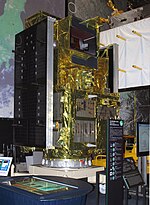cosmos.wikisort.org - Spacecraft
The Greenhouse Gases Observing Satellite ('GOSAT), also known as Ibuki (Japanese: いぶき, Hepburn: Ibuki, meaning "breath"[4]), is an Earth observation satellite and the world's first satellite dedicated to greenhouse gas monitoring.[5] It measures the densities of carbon dioxide and methane from 56,000 locations on the Earth's atmosphere.[6] The GOSAT was developed by the Japan Aerospace Exploration Agency (JAXA) and launched on 23 January 2009, from the Tanegashima Space Center.[6] Japan's Ministry of the Environment, and the National Institute for Environmental Studies (NIES) [7] use the data to track gases causing the greenhouse effect, and share the data with NASA and other international scientific organizations.[5]
 Model of GOSAT at Tsukuba Space Center Space Dome | |
| Names | Ibuki |
|---|---|
| Mission type | Environmental |
| Operator | JAXA |
| COSPAR ID | 2009-002A |
| SATCAT no. | 33492 |
| Website | global |
| Mission duration | 5 years (planned) Elapsed: 13 years, 8 months, 15 days |
| Spacecraft properties | |
| Manufacturer | Mitsubishi Electric |
| Launch mass | 1,750 kilograms (3,860 lb)[1] |
| Power | 3.8 kilowatts[1] |
| Start of mission | |
| Launch date | 23 January 2009, 03:54 UTC |
| Rocket | H-IIA-202 F15 |
| Launch site | Tanegashima, Yoshinobu 1 |
| Contractor | Mitsubishi Heavy Industries |
| Orbital parameters | |
| Reference system | Geocentric |
| Regime | Low Earth[2] |
| Perigee altitude | 674 kilometres (419 mi)[3] |
| Apogee altitude | 676 kilometres (420 mi)[3] |
| Inclination | 98.06° [3] |
| Period | 98.12 minutes[3] |
| Mean motion | 14.68[3] |
| Epoch | 25 January 2015, 03:12:11 UTC[3] |
| Main Instrument | |
| Wavelengths | 12900 - 13200 cm−1/ 5800 - 6400 cm−1/ 4800 - 5200 cm−1/ 700 - 1800 cm−1(FTS)[1] |
| Resolution | 0.2 cm−1 (FTS) |
| Instruments | |
| TANSO-FTS - Infrared Fourier Transform Spectrometer TANSO-CAI - Thermal and Near-Infrared Sensor | |
Launch
GOSAT was launched along with seven other piggyback probes using the H-IIA, Japan's primary large-scale expendable launch system, at 3:54 am on 23 January 2009 UTC on Tanegashima, a small island in southern Japan, after a two-day delay due to unfavourable weather.[6][5] At approximately 16 minutes after liftoff, the separation of Ibuki from the launch rocket was confirmed.[8]
Instruments
According to JAXA, the Ibuki satellite is equipped with a greenhouse gas observation sensor (TANSO-FTS) and a cloud/aerosol sensor (TANSO-CAI) that supplements TANSO-FTS. The greenhouse gas observation sensor of Ibuki observes a wide range of wavelengths (near-infrared region–thermal infrared region) within the infrared band to enhance observation accuracy.[8] The satellite uses a spectrometer to measure different elements and compounds based on their response to certain types of light. This technology allows the satellite to measure "the concentration of greenhouse gases in the atmosphere at a super-high resolution."[9]
GOSAT-2
The Greenhouse Gases Observing Satellite-2 or GOSAT-2, also known as IBUKI-2 (COSPAR 2018-084B) was launched from Tanegashima Space Center by a H-IIA rocket on October 29, 2018.[citation needed]
See also
- Orbiting Carbon Observatory 2
- Space-based Measurements of Carbon Dioxide
References
- "Outlines of GOSAT and TANSO Sensor" (PDF). Archived from the original (PDF) on 5 February 2009. Retrieved 26 January 2009.
- "Orbit Insertion of the Greenhouse Gases Observing Satellite "IBUKI" (GOSAT)" (PDF) (Press release). JAXA. Retrieved 26 January 2009.
- "GOSAT (IBUKI) Satellite details 2009-002A NORAD 33492". N2YO.com. 25 January 2015. Retrieved 25 January 2015.
- "'IBUKI' Chosen as Nickname of the Greenhouse Gases Observing Satellite (GOSAT)" (Press release). JAXA. 15 October 2008. Retrieved 29 May 2009.
- "Japan launches rocket with greenhouse-gas probe". Associated Press. 23 January 2009. Retrieved 23 January 2009.
- Fujioka, Chisa (23 January 2009). "Japan launches satellite to monitor greenhouse gases". Reuters. Retrieved 23 January 2009.
- "国立環境研究所". Nies.go.jp. Retrieved 11 April 2022.
- "Greenhouse gases Observing SATellite "IBUKI"(GOSAT)". Japan Aerospace Exploration Agency. Retrieved 23 January 2009.
- Gerein, Keith (21 January 2009). "Alta. scientists to track greenhouse gases from space". Calgary Herald. Archived from the original on 31 January 2009. Retrieved 24 January 2009.
External links
- GOSAT site by JAXA
- GOSAT site by NIES
- GOSAT-2 site by NIES
На других языках
[de] Greenhouse Gases Observing Satellite
Der Greenhouse Gases Observing Satellite (GOSAT), auch bekannt als japanisch Ibuki (.mw-parser-output .Hira{font-size:120%}いぶき, dt. „Atem; Hauch“), ist ein Erdbeobachtungssatellit und der erste Satellit, der zur Überwachung von Treibhausgasen eingesetzt wird.[2] Er misst die Verteilung von Kohlendioxid und Methan an 56.000 Punkten der Erdatmosphäre.[3] GOSAT wurde von der japanischen Weltraumagentur JAXA entworfen und am 23. Januar 2009 vom Tanegashima Space Center mit einer H-IIA gestartet. Bisher gibt es lediglich 282 landgestützte CO2-Messpunkte (Stand Oktober 2008), von denen sich die größte Zahl in den USA, Europa oder anderen Industrienationen befindet.[3]- [en] Greenhouse Gases Observing Satellite
[es] Ibuki (satélite)
El satélite Ibuki (いぶき, Ibuki?), en japonés respiro (también conocido en inglés como GOSAT, Greenhouse Gases Observing Satellite) es el primer satélite de observación terrestre dedicado a medir en forma regular los gases invernadero en la atmósfera terrestre. Ibuki será capaz de medir la cantidad de dióxido de carbono y metano en más de 56.000 puntos de la atmósfera.[ru] Ibuki
Ибуки (яп. いぶき Ибуки, Дыхание) — спутник дистанционного зондирования Земли, первый в мире космический аппарат, чьей задачей является мониторинг парниковых газов.[1] Также спутник известен как The Greenhouse Gases Observing Satellite («Спутник для мониторинга парниковых газов»), сокращённо GOSAT. «Ibuki» оборудован инфракрасными датчиками, которые определяют плотность углекислого газа и метана в атмосфере. Всего на спутнике установлено семь различных научных приборов.[2][3] «Ibuki» разработан японским космическим агентством JAXA и запущен 23 января 2009 года с космодрома Танегасима.[3] Запуск был осуществлён с помощью японской ракеты-носителя H-IIA.Другой контент может иметь иную лицензию. Перед использованием материалов сайта WikiSort.org внимательно изучите правила лицензирования конкретных элементов наполнения сайта.
WikiSort.org - проект по пересортировке и дополнению контента Википедии